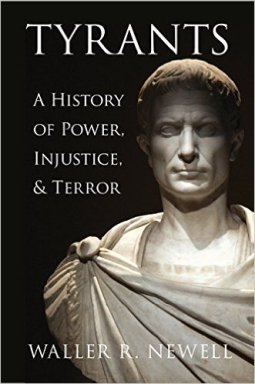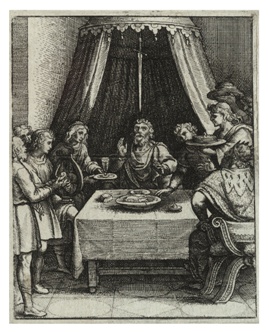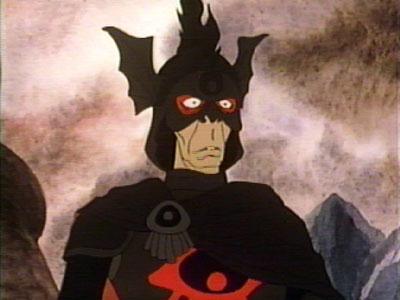Dark Lords Through History: Waller Newell’s Tyrants

Remember the Sword of Damocles?
Damocles flatters King Dionysus; “Lord! How fortunate and god-favored you are to be so powerful!”
The king — really a tyrant — says, “Sure. Let’s change places for a day.”
So, Damocles has a right old time feasting and carousing, right up until the moment Dionysus points out the sharp sword hung over his head, suspended by just one fraying thread…
Eek!
The take home is, WHY ON EARTH WOULD YOU WANT TO BE A TYRANT, YOU IDIOT? EVERYBODY WILL TRY TO KILL YOU.
And that’s one of the questions that Professor Waller R. Newell sets out to answer in his Tyrants: A History of Power, Injustice, and Terror (the which I talked his publisher into sending me as a nice follow up to Holland’s book on the Caesars.).
By “tyrant”, he means a ruler with personal power unconstrained by law or custom.

A medieval king doesn’t always need to be a tyrant, but a Roman emperor invariably is. Tyrants aren’t always evil, but it’s all too easy for them to do evil on whim — like Emperor Hadrian executing an architect who argued with him (“And Hadrian was one of he so-called Good Emperors,” notes Professor Newell.) Tyrants can also be groups or even states, e.g. Athens with its “allies.”
So it really is “Dark Lords Through History (And Why They Did It).”
The book is part political theory and part manifesto, and firmly addressed to the modern audience: Professor Newell is an inverse Machiavelli intent on teaching the population to avoid falling under the sway of powerful (usually) men, rather than the other way around.
However, it’s also part political history, much of it grim for all that it is wittily told.
Combine the history and theory and you have a book that spins the kind of yarn we like — dramatic tales of power and corruption. At the same time helps those of us who worldbuild — for writing or gaming — to imagine realistic tyrants; to build our own dark lords in the sandboxes of our imaginations. (If you are reflective enough to create a secondary world, you may, like me, have difficulty really “getting” why anybody would want to seize power, in which case you need this book.)
To give you a taste, I asked the professor how Palpatine and Sauron would fit into his theories:
Palpatine strikes me as a classic example of a reforming tyrant, bearing in mind that these figures often have extremely mixed motives and often degenerate into mere kleptocratic garden variety oppressors. Somewhat like Octavian Caesar, Senator Palpatine comes forward as the ostensible defender of the Republic against external threats that he has stoked behind the scenes. After getting the Senate to make him Chancellor, his becomes ever more dictatorial, demanding emergency powers — like Hitler after the Reichstag fire — and refusing to relinquish his office. Finally he dismantles the Republic and proclaims himself Emperor. It’s interesting when you watch the movies that, although we all know that Palpatine will become the sinister figure, cankered with evil, in the sequel, in the prequel, he initially comes across as quite plausible to those around him in his seemingly sincere wish to protect Republican liberty through temporary emergency measures. This is a figure we see often in the history of tyranny.
I would have to classify Sauron as a millenarian tyrant. Although he has a bottomless craving for power, he isn’t a mere kleptocrat, and hedonistic pleasure seems to play no role in his dark, amorphous existence. And he certainly isn’t a reformer —sheer malevolent destruction is his sole element. But there is a way in which Sauron is not merely a political figure, but the embodiment of the entire constellation of evil forces in the world, whose dark powers he can tap. He is resisted by Gandalf and the Western alliance, who in turn embody the powers of light and goodness in the world. So there is something apocalyptic about the struggle against Sauron, a battle between goodness and evil evoking Zoroastrianism and, of course, the fallen angel Lucifer. Millenarian tyrannies, as I argue, although secular in character, tap into and imitate apocalyptic themes of the struggle between good and evil in the world. It’s no accident that Hitler drew such inspiration from Wagner’s operas —also an influence on Tolkien’s LORD OF THE RINGS — because Wagner’s tales of a new era of Nordic heroism that will once again shake the world fit Hitler’s fantasy about the struggle of the National Socialist ‘world-view’ to bring peace and justice to mankind. Many millenarian revolutions —including the Jacobins and Bolsheviks —have a pseudo-religious vision of a final struggle between good and evil culminating in earth-shaking massacre and war as the prelude to a new era.

The book is really an essay wrapped around a history.
I suspect if it were written thirty years ago, then it would be just an essay: back then, educated people knew all about Pericles and Augustus and Robespierre and Napoleon. But because we live in the busy, flittery 21st century, it is a history, and a sweeping one: in his chatty, personable lecturing style — with geek culture references, by the way — Professor Newell outlines his theory, then blasts through history from Troy, through Napoleon and Hitler, to ISIS, then sums up and suggests survivable ways forward for civilisation.
It’s a mesmerising read. However, immediately you can see two reasons why academics seem to shy away from such generalising projects.
First, the broad sweep means that there will be errors or debatable facts: you and your editors can’t be experts at everything! For example, a typo on page 86 conflates King Harold with King Alfred — as a historical novelist, I point this out with complete sympathy.
Second, any sweeping history is going to come to conclusions about the way the world works, and that makes it political. Newell is interested in masculinity, thinks the literary classics are a way of teaching young men empathy, has low expectations of human behavior and motivations, is scathing about grand leftish projects and passionate about political freedom. He also believes that most terrorists are really “tyrants in waiting”. I think this places him in “old-fashioned conservative” portion of the American political spectrum, meaning you may or may not like his politics, but you will certainly react to them. Not all academics want to nail their colours to the mast in this way. Also, I’ll wager not all publishers want to risk publishing a book that might result in them being wheedoned on social media.

However, the result is bound to be a classic. It’s meaty in the way a good post-pub Chinese meal is: brain-filling while presented in spicy bite-sized chunks. Read it just to understand what Machiavelli really believed, about Locke and the Leviathan, and about the Enlightenment, Robespierre and… ah yes, the professor is something of an erudite raconteur. I bet his lectures are entertaining.
Most importantly for worldbuilders, he sets out and illustrates a really handy typology of Tyrants:
Garden Variety Tyrants — Rulers who run a society for their own benefit or that of their kin. Often no more than appetite empowered, they can be anything from carousing old-style robber barons through to partying modern kleptocrats siphoning off international aid. They leave behind a reputation for excess, and are rarely mourned. Think: Nero and Papa Doc Duvalier.
Reforming Tyrants — Rulers just want to fix things. Ruthless but rational, they’re usually abstemious to the point of personal puritanism, and are often revered as “fathers of the nation.” The line between Great Statesman and Reforming Tyrant is a bit blurred . They also often degrade into the Garden Variety. Think: Augustus and Napoleon.

Millenarian Tyrants — Dangerous idealists who want to reboot society in order to trigger the millennium (or “Year 0”), in which humans return to a pre-historical state of Utopian bliss where everything is in common, and we are all equals (except for (a) those who are more equal than others, and (b) the enemies of the people, who have been eliminated). The snag is that since a Utopian scheme is infinitely good, any amount of collateral damage is justified, and enemies who stand in its way are infinitely bad and can be punished as such. Invariably, this kind of tyrant categorises whole groups of people as obstacles and enemies, meaning that these rulers are usually best remembered for their genocidal crimes. Such tyrants aren’t reality-based — when the facts get in the way, they just kill more people. Oh, and if they can’t have the millennium, they’ll settle for a nice Gotterdammerung with the state as a funeral pyre. Think: Robespierre and Hitler.
Which takes us back up to what Newell said about Palpatine and Sauron (see above).
So.
If you are interested in what my old Classics prof called “technicolor history”, then this is a good engrossing read,with ideas clearly set out and history spun in engaging yarns. If you are a writer or GM, you will also find this a supremely inspiring book that helps make sense of tyranny both politically and psychologically, and is packed with examples that themselves could be jumping off points for adventures.
I shall certainly come back to this book more than once both as both history buff and author.
Tyrants: A History of Power, Injustice, and Terror by Waller R. Newell is published by Cambridge University Press and available in hardback. It has no illustrations (which it doesn’t need; this is a book of ideas), and the index is only adequate, so you are as well buying the more searchable (but only slightly cheaper) ebook.
M Harold Page is the Scottish author of works such as Swords vs Tanks (Charles Stross: “Holy ****!”). For his take on writing, read Storyteller Tools: Outline from vision to finished novel without losing the magic. (Ken MacLeod: “…very useful in getting from ideas etc to plot and story.” Hannu Rajaniemi: “…find myself to coming back to [this] book in the early stages.”)
Sounds like a delightful and useful book. Your inquiry re Sauron and Palpatine is inspired.
I’m confused by your use of “wheedoned.” I’m assuming a Joss Whedon etymology here, in which case the word is usually used to talk about killing off a beloved character in the 3rd Act or some analogous moment, usually in ways the audience finds unnecessary. Ned Stark totally gets Whedoned. Come to think of it, if you want to warn your audience of the impending Whedoning of any character, just cast Sean Bean. You’re definitely talking about something else, though I’ve received enough rejection letters to enjoy imagining the Whedoning of an entire publishing house. : )
“Whedoned” describes the experience of being driven off social media due to some apparently heinous act that however requires several sentences and some jargon to explain.